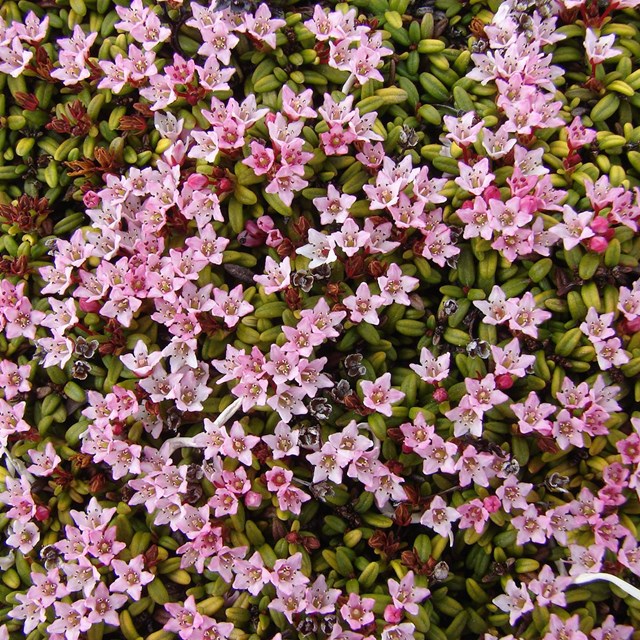|
A far cry from the white wonderland of winter, in summer, the tundra (natiknaq) of Bering Land Bridge National Preserve awakens in a brilliant kaleidoscope of wildflowers. From the deep purple of the poisonous Monkshood to the bright pink of the Common Fireweed, the landscape offers an endless selection of flora to identify. Check out some of the most common tundra wildflowers below! 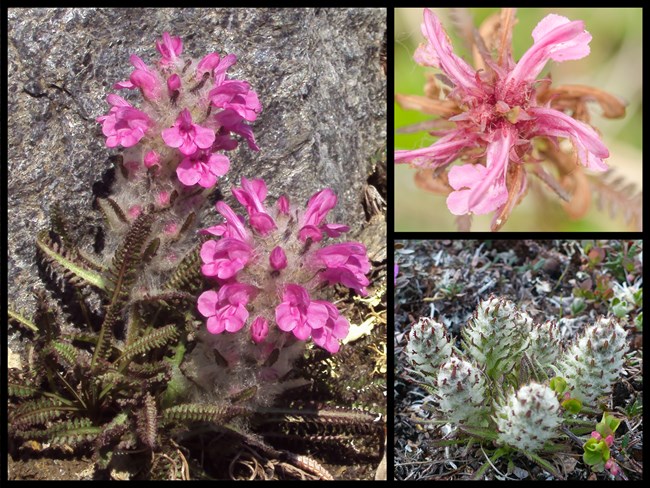
NPS Photo Woolly Lousewort(Pedicularis dasyantha) Named for the remarkable adaptation that gives it its unusual appearance, Woolly Lousewort can be found in stony tundra areas across northern Alaska. The "wool" is a layer of fuzzy insulation that wraps around the stem of the plant, protecting it from wind and cold. Like the glass of a greenhouse, the wool can trap solar energy and hold warm air around the plant, allowing it to grow in harsh arctic conditions. Woolly Lousewort usually has a single thick stem, or occasionally a few stems clustered together, and grows around 6 inches tall. The pink or purple flowers bloom in a cluster at the end of the stem. When young, flowers are covered with dense wool. As warmer weather arrives, the flowers break through the wool, painting the landscape in shades of rose. The entire plant is edible and has a history of food use by humans. The blossoms can be eaten raw and have a lightly sweet taste. Inupiat have a dish similar to sauerkraut where the flowers are covered with water and left in a barrel to ferment. The leaves and stems can be cooked and added to a number of dishes like soups or casseroles. Woolly Lousewort's thick fleshy taproot, which helps it grow in drier climates, is similar in flavor and texture to a young carrot, and can be used in a variety of recipes or eaten raw. 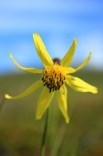
NPS Photo / Katie Cullen Alpine Arnica(Arnica alpina) Related to daisies and asters, Alpine Arnicas are one of many varieties found in Alaska. They are usually seen around June and July on dry alpine and sub-alpine slopes. 
NPS Photo / Mason London Alpine Forget-me-not(Myosotis alpestris) The Alpine Forget-me-not is a member of the borage family. It is found in alpine and sub-alpine meadows and slopes throughout Alaska. Blooming May–June, these tall, delicate beauties are the state flower of Alaska. 
NPS Photo / Andrea Willingham Fireweed (Inupiaq: qinighavgi)(Epilobium) Both Common Fireweed (Epilobium angustifolium) and Dwarf Firewed (Epilobium latifolium) are common on the Seward Peninsula. While both bloom from about July–August, Common Fireweed is taller and its leaves turn bright orange-red in the fall, while Dwarf Fireweed is low-growing and commonly found along streams and rivers. 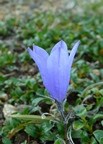
NPS Photo Harebell(Campanula) Both Mountain Harebell (Campanula lasiocarpa) and Common Harebell (Campanula rotundifolia) are found on the tundra of Bering Land Bridge. Mountain Harebell is very small and grows solitary on rocky alpine slopes, while Common Harebell is tall and slender, growing in clumps on grassy slopes and rocky outcroppings. 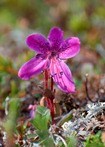
NPS Photo / Andrea Willingham Kamchatka Rhododendron(Rhododendron camtschaticum) At first glance, the Kamchatka Rhododendron might resemble Dwarf Fireweed, but on closer inspection, it's actually significantly different. Blooming late-May to mid-June, this low-growing wildflower thrives on tundra slopes throughout the Seward Peninsula. 
NPS Photo / Alison Carlyle Labrador Tea (Inupiaq: saayuliuqtaaluta)(Ledum palustris) In summer, the tundra will be fragrant with the zesty aroma of Labrador Tea, which blooms in June in wet boggy areas. As a low-growing shrub, it is recognizable by its long, thin leaves. Although it can be brewed into a tasty tea, it contains low levels of a mild poison and should be consumed only in moderation. 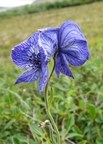
NPS Photo Monkshood(Aconitum delphinifolium) Also commonly called wolfsbane, the Monkshood is a poisonous plant that blooms in July and August on the sloping tundra. Monkshood is a member of the buttercup family, and is easily recognized by its deep purple lobed petals that grow on long, thin stems. 
NPS Photo / Alison Carlyle One-flowered Cinquefoil(Potentilla uniflora) One-flowered cinquefoil is one of many varieties of cinquefoil in the rose family. They bloom mid-May through mid-June, are most commonly found on rocky, exposed slopes, and almost always have 5 petals with an orange spot at the base. 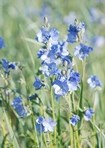
NPS Photo / Mason London Tall Jacob's Ladder(Polemonium acutiflorum) Found in wet fields and often near streams, Tall Jacob's Ladder blooms in July and August as a tall perennial plant. It often has clumps of flowers with 5 pointed blue petals at the top of a long stem. More Plants at Bering Land Bridge
|
Last updated: December 16, 2025

